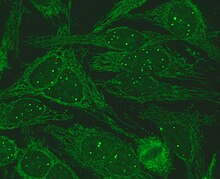Sp100 nuclear antigen
| SP100 nuclear antigen | |||||||
|---|---|---|---|---|---|---|---|
| Identifiers | |||||||
| Symbol | SP100 | ||||||
| NCBI gene | 6672 | ||||||
| HGNC | 11206 | ||||||
| OMIM | 604585 | ||||||
| RefSeq | NM_003113 | ||||||
| UniProt | P23497 | ||||||
| Other data | |||||||
| Locus | Chr. 2q37.1 | ||||||
| |||||||
Sp100 nuclear antigenis aninterferonstimulatedantigenfound in the cell nuclei of many human and higher animal cells. Autoantibodies directed against Sp100 are often found in patients withprimary biliary cirrhosis.[1]Histologically Sp100 'dots' regions of the cell nucleus. Viral infection andmitogensaffect the expression of the Sp100 autoantigen. Cells grown in the presence ofinterferons(α, β, and γ) revealed an increase both in size and number of the Sp100 protein-containing nuclear dots and increase the protein concentration. This raises "the question whethercytokine-mediated increase of Sp100 protein expression plays a role in induction ofanti-Sp100 autoantibodies."[2]
Sp100 and nuclear dots
[edit]
Two proteins, Sp100 and promyelocytic leukemia (PML) factor are localized to punctate domains in the nucleus (nuclear dotsor nuclear bodies). These domains (few to 20) were found to form a donut-shaped structure when cells were starved of amino acids. In particular, deprivation of cystine results in most pronounced changes.[3]Two other proteins, PIC1/SUMO-1,that also interact withnuclear porecomplex factors also interact with these two proteins.[4]In addition Sp100 interacts with a chromatin binding protein, HP1 alpha.[5]
Sp100 splicoforms
[edit]Some Sp100 variants contain a domain similar to two interferon-inducible nuclearphosphoproteins,suppressinandDEAF1.This defines a novel protein motif, the HNPP-box. Another class of variants hashigh mobility group1 (HMG1) protein sequence as a domain. Both major classes of Sp100 splice variant proteins localize in part to nuclear dots/PML bodies and other nuclear domains.[6]
References
[edit]- ^Szostecki C, Guldner HH, Netter HJ, Will H (1990)."Isolation and characterization of cDNA encoding a human nuclear antigen predominantly recognized by autoantibodies from patients with primary biliary cirrhosis".J. Immunol.145(12): 4338–47.doi:10.4049/jimmunol.145.12.4338.PMID2258622.S2CID43572051.
- ^Guldner HH, Szostecki C, Grötzinger T, Will H (1992)."IFN enhance expression of Sp100, an autoantigen in primary biliary cirrhosis".J. Immunol.149(12): 4067–73.doi:10.4049/jimmunol.149.12.4067.PMID1281200.S2CID20921655.
- ^Kamei H (1997). "Cystine starvation induces reversible large-body formation from nuclear bodies in T24 cells".Exp. Cell Res.237(1): 207–16.doi:10.1006/excr.1997.3790.PMID9417884.
- ^Sternsdorf T, Jensen K, Will H (1997)."Evidence for covalent modification of the nuclear dot-associated proteins PML and Sp100 by PIC1/SUMO-1".J. Cell Biol.139(7): 1621–34.doi:10.1083/jcb.139.7.1621.PMC2132645.PMID9412458.
- ^Seeler JS, Marchio A, Sitterlin D, Transy C, Dejean A (1998)."Interaction of SP100 with HP1 proteins: a link between the promyelocytic leukemia-associated nuclear bodies and the chromatin compartment".Proc. Natl. Acad. Sci. U.S.A.95(13): 7316–21.Bibcode:1998PNAS...95.7316S.doi:10.1073/pnas.95.13.7316.PMC22602.PMID9636146.
- ^Guldner HH, Szostecki C, Schröder P, et al. (1999). "Splice variants of the nuclear dot-associated Sp100 protein contain homologies to HMG-1 and a human nuclear phosphoprotein-box motif".J. Cell Sci.112. ( Pt 5) (5): 733–47.doi:10.1242/jcs.112.5.733.PMID9973607.
